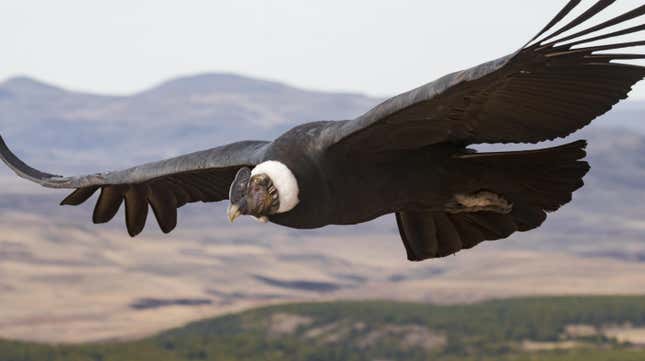
The world’s largest soaring bird—the Andean condor—can stay aloft for 5 hours and cover more than 100 miles of real estate without flapping its wings, according to new research.
Weighing upwards of 33 pounds (15 kg) and with a wingspan reaching 10 feet (3 meters), Andean condors are a physically impressive species. New research published this week in the journal Proceedings of the National Academy of Sciences shows the dramatic extent to which these scavengers can stay aloft and conserve energy as they patiently search for carrion on the ground.
Gliding from one air current to another, Andean condors spend nearly all of their flying time in this soaring mode, flapping their wings a mere 1.3% of the time, according to the new research, co-authored by Swansea University biologist Emily Shepard.

From 2013 to 2018, Shepard and her colleagues tracked eight Andean condors near Bariloche, Argentina, which they did by attaching flight-recorders capable of logging every wingbeat made by the birds during flight. The purpose of this exercise was to measure the effects of different weather conditions on condor flight. In total, the scientists managed to chronicle some 250 hours of data.
In the most extreme example, an Andean Condor spent five hours in the air without having to flap, during which time the bird covered 106 miles (172 km). David Lentink, a biologist from Stanford University who wasn’t involved in the new study, described the results as “mind-blowing,” as he told The Guardian.
As the data showed, around 75% of the flapping that did occur happened as the condors were taking off. This points to a big physical cost to the birds and a good reason for them to avoid unnecessary landings and takeoffs.
“Soaring birds fly under weather conditions that allow them to stay airborne with the absolute minimum of movement costs, but there are times when these birds must resort to extremely costly flapping flight,” explained Hannah Williams, a co-author of the study and a postdoctoral researcher at the Max Planck Institute for Animal Behavior, in a press release.
These near-flapless soaring sessions occurred when the conditions were both calm and windy, but flapping happened more often in the early morning as gusts of warm wind, or thermal updrafts, were starting to form and rise very slowly.
“Our findings suggest that in-flight decisions of when and where to land and when to move between airflows are crucial, as not only do condors need to be able to take off again after landing, but unnecessary landings will add significantly to their overall flight costs,” said Williams.
Looking ahead, the researchers would like to understand the inflight decision-making of the condors and how they’re able to bounce so effortlessly from one thermal updraft to the next. At the same time, the new research could explain how early avian dinosaurs like Archaeopteryx, which were also quite large, might have flown without having to expend too much energy.